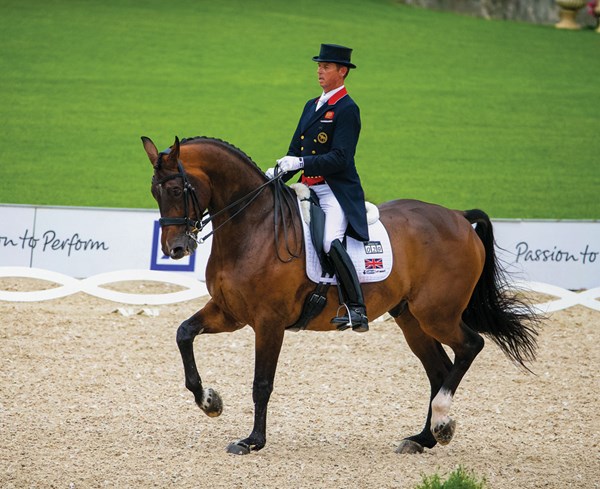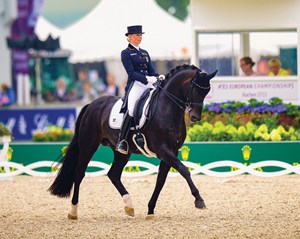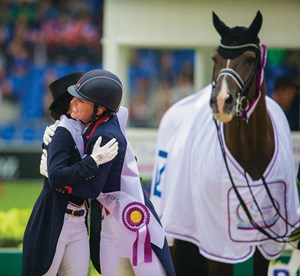
As a dressage rider, you may strive for perfection. Do you want to be the best-possible rider? The best-possible trainer? Maybe you want to be on an international team. I had the fabulous opportunity to travel to Aachen, Germany, for the 2015 European Championships as a chaperone for The Dressage Foundation’s International Dream trip. Not only did I experience the competition among many of the world’s best horses and riders, but I spoke with many trainers and learned, straight from the source, what they did to get to the top of the sport. They were each incredibly generous in sharing their time and knowledge. They explained what the rider and horse need to succeed and how to make it from the warm-up ring to the show ring in top competitions.
Developing Feel

Experts agreed that feel is the most important aspect of the rider’s seat. Many countries have systems to identify talented young riders and guide them toward Grand Prix success. But talent is not enough. Riders have to push themselves to improve their feel.
Dressage legend Kyra Kyrklund explained how the rider educates the seat to develop feel. In the beginning, you might have the right feeling only for a moment. This is when you begin to connect the correct neurons from your brain to your body for the right feel. “At this point, the connection is a small and twisted path,” she said. Over time, you find the right feeling again and again. After many repetitions, the path gets bigger and easier to navigate. “When your seat is educated,” she said, “the neuron path becomes a highway.”
British Olympian Carl Hester suggested that the best way to develop feel comes from the experience of training many horses to Grand Prix. “A top rider has talent for feel and timing,” he said. “The best way to develop that is to train horses up the levels.”
He pointed out that Grand Prix riders know the movements inside and out. When they know the movements that well, they own them: They can perform them any time, any place. This allows riders to adjust to whatever situation they might find in competition.
One of Germany’s youth coaches, Hans Heinrich Meyer zu Strohen, said, “You have to work first on yourself. If you want to be a top rider you have to have a top-quality seat.” He stressed the importance of feel and contact as important traits among the top riders. He suggested the best way to develop the seat is to have eyes on the ground, and not just anyone will do. Riders need someone who will be hard on them when necessary and yet someone whom they can feel comfortable relaying questions to.
Jan Bemelmans, a Belgian-born German and chef d’equipe for the French, said many riders on top teams often grew up riding bareback. They are riders who have taken many longe lessons without reins and/or stirrups. “That is how you develop body control and feel,” he said.
Henk van Bergen, an international trainer who has coached many teams, talked about how to achieve your goals as a rider. “If you want to get somewhere,” he said, “you have to work a little harder and be a little better than anyone else.”
You might have a dream to be on a team, move to the next level or simply improve one movement. Ultimately, he said, “You have to be happy if you are better tomorrow than you are today.”
Developing the Horse

A successful rider needs a top horse. Maybe it is your own horse or perhaps you train him for someone else. Bemelmans stressed that the horse has to have good gaits, “but you win with the personality,” he said.
“Many good horses are difficult to start.” He spoke of horses with a strong personality and lots of energy being the best at the top of the sport, but perhaps are easily offended or strong-headed in the beginning of their training.
Hester agreed that you can’t guarantee a trainable horse by his or her talented gaits. He suggested that you find a horse with a nice walk, trot and canter but then you have to sit on him. Feel his temperament and measure his reactions to your aids. If he has a good reaction, you can teach him anything.
When it comes to starting these horses, Hester said he and British double-Olympic-gold medalist Charlotte Dujardin don’t personally do the breaking in. The horses they train were ideally started for about a month as 3 1/2-year-olds then turned out until the beginning of the year when they are 4, which is when the formal training begins.
Kyrklund agreed that when she looks for a horse, she tries to find one with an exceptional personality. She is aware of the bloodlines but does not solely use them to make her decision. “Horses are individuals,” she said. She looks at the sire, but advised, “They have a mother, too.”
Training and Fitness
When you train the horse from the beginning to the highest levels, it is perhaps most important to keep him sound. Kyrklund is a huge proponent of walking. She makes sure her horses are hand-walked daily to keep them fit and loose and also to keep their minds active by exploring the surroundings.
Kyrklund also suggests experimenting with the riding schedule to find what works best to train the horse and yet not overwork him and make him cranky or wear him out. She sometimes schools her horses and works on the trot one day and then on the canter the next. Some days she focuses mostly on the horse’s outline. To determine the right schedule, she listens to the horse. “He will tell you what he needs,” she said. She first teaches the horse what is easiest for him to learn. For example, if the horse is ready to learn piaffe and passage as a 6-year-old, she starts to play with the half steps and doesn’t wait until the canter is at the same level of collection. Some horses have talent for particular movements that can be utilized to improve their work without asking too much from them.
Hester has an organized way to train his horses week by week. He found out early on that horses are better the second day of riding, so he breaks the week into two sets of three days plus a day off. The horses work two days and then hack out on the third. This puts them in the best position to learn. He also keeps the training sessions short, about 20 minutes. Before he gets on to train, the groom has walked the horse and has done a stretching warm-up. Hester trains the horse and then the groom walks him again. Hester believes that all the walking is very important for fitness as well as soundness.
“A Grand Prix rider has a Grand Prix horse in mind every time he or she rides,” Hester said. The sound and happy horses that make Grand Prix as 9-year-olds do so not because they were overtrained, but because the rider accessed the horse’s temperament and made it easy for him to learn.
Beatriz Ferrer-Salat of Spain won the bronze medal in the Grand Prix Freestyle at the European Championships on the 14-year-old Westfalen, Delgado. She started working with him as a 6-year-old. She said he was difficult to keep sound, but she knew it was worth it to keep trying. She found the weekly regiment that worked best for Delgado includes one or two days of work, two days of hacking and two days riding out on the racetrack. He also receives regular massage and chiropractic treatments.
During the journey of training a horse to the international levels, many coaches, sponsors, veterinarians, etc. become involved with the horse-and-rider team. The experts agreed that the rider knows the horse best. “The rider has to stand up for the horse,” explained Kyrklund. “It is the rider’s responsibility to speak up if he or she thinks something is wrong.”
In the Warm-up Ring

At the show, the quality of the warm-up is directly related to the performance of the horse and rider in the ring. Oliver Oelrich, one of Germany’s youth coaches, stresses the importance of not trying to train the horse in the warm-up ring at the show. “The warm-up,” he said, “is 30 to 35 minutes of gymnastic and elastic work. If you try to train the horse during this time, he is not prepared to learn.”
“The goal in warm-up is relaxation,” Hester believes. He does a lot of stretching during this time but makes sure the horse is sharp and in front of the leg. He does the same warm-up routine at home and at the show, which helps to promote relaxation.
Bo Jena, chef d’equipe of the Swedish team, agreed and added that the warm-up is the most important aspect of competing. The horse’s energy and suppleness improve over time during the ride, but he reaches a peak and then begins to decline. You need to know when that peak occurs and at that time be in the show ring to show your best work, he explained.
Kyrklund said, “The warm-up is not a competition.” She does not want to show off in the warm-up ring. She wants to save it for the show ring. If the horse has a problem with something during the warm-up, she tries to break the issue down and make it easier for him and not push it head-on. She wants the horse calm, cool and through, ready to go in and show.
The Show Ring
When Hester goes into the show ring, he visualizes the best test he did at home. He knows the movements inside and out, so in the ring he knows how to ride each movement at his best, finish it and then ride the next. His explanation sounded simple enough, but as he discussed it further, I could tell what he said was profound. During the test he is present in every stride and every moment. His exceptional feel is utilized at 100 percent for the whole test. That is what separates good riders from the stars of the dressage world.
Katrina Wuest, the president of the ground jury at Aachen 2015, explained that there are many qualities she notices to get an impression of a rider’s education. She rewards a rider who is precise with the line of travel, accurate in the movements and who prepares transitions well. She especially notes the first halt, which makes a first impression. She gets an overall idea of how the connection and balance are in the ride, which influences the score for each movement.
It is impossible to replicate the atmosphere and desensitize the horse in advance to a stadium such as the one at Aachen. Hester uses the hack days to get the horses out on the road to experience a variety of spooky situations.
Mikala Münter Gundersen, an international dressage competitor of Denmark, said she and her horse, My Lady, have done many shows and have many miles behind them, which makes the stadium more friendly.
No matter what the atmosphere is like, Bemelmens suggested, “At the competition, the rider needs to keep his or her cool.” There is a lot of pressure and a lot going on that is beyond anyone’s control. To make it, the rider also needs a little luck.
Dujardin, who leads the sport with record scores, got an 89.054 percent in the Kür at Aachen 2015. She was asked if she was afraid of German rider Kristina Bröring-Sprehe, whose scores were closing in at 88.804 percent. “It doesn’t make me afraid,” she said, “It makes me fight harder.” That is the attitude of a true champion.
Jessica von Bredow-Werndl’s Warm-up
One of the most pleasing schooling rides witnessed at Aachen 2015 occurred on the day off before the Grand Prix Special. German rider Jessica von Bredow-Werndl rode Unee BB in a way that expertly demonstrated the feel required of an international rider. After many minutes of walking, she began her ride with a stretching trot followed by a little hand-gallop in a light seat. Unee BB at first seemed reluctant to open up in the hand-gallop, but it was clear that von Bredow-Werndl was encouraging him in a playful way with her aids, and by the end of the warm-up, her horse looked much looser and more energetic.
She began schooling the canter first and continued to incorporate her playfulness to keep Unee BB active, especially in the changes, which she practiced on the track. She gave him many breaks and was quick to pat and encourage him. When she began to work on the trot, she removed her stirrups. She was not only working on the horse, she was working on herself. The piaffe and passage work got better and better, and it was clear how she was stable in her seat yet was able to encourage Unee BB to lift off the ground by almost lightening herself. She had short work sessions followed by breaks. At the end of the ride she stretched him again in rising trot without stirrups. During the entire ride, von Bredow-Werndl had the biggest smile across her face. She was clearly enjoying her ride and happy to be there.











